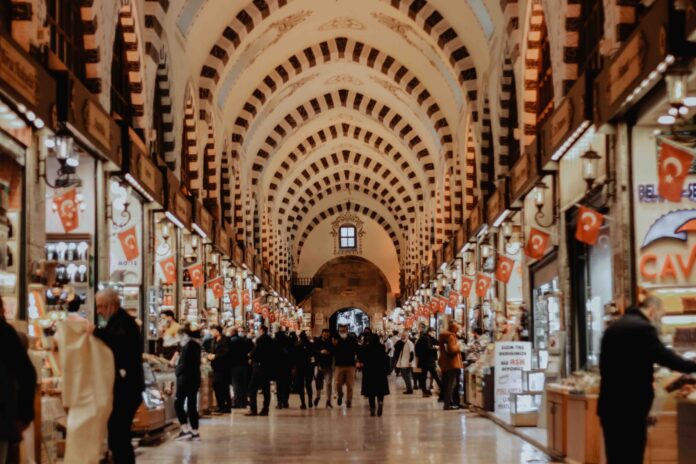The Grand Bazaar: A Treasure Trove of Turkish History and Culture
Stepping into the Grand Bazaar in Istanbul is like stepping back in time. Considered one of the oldest and largest covered markets in the world, this iconic attraction is more than just a shopping destination. It’s an experience that is deeply ingrained in Turkish culture and history.
Step by Step Guideline to Grand Bazaar
Brief Overview of the Grand Bazaar
The Grand Bazaar, also known as Kapalıçarşı in Turkish, is a sprawling maze-like market that spans over 60 streets and contains thousands of shops. It was first established during the Ottoman Empire in the 15th century by Sultan Mehmed II. The bazaar was initially built as a center for trade and commerce to boost the economy during his reign.
Over time, it grew into an epicenter for cultural exchange where people from all walks of life would come together to trade goods, share stories, and forge connections. Today, it remains a hub for locals looking to purchase traditional hand-made goods as well as tourists seeking unique souvenirs to take home.
Significance of the Grand Bazaar in Turkish History
The Grand Bazaar played a significant role throughout Turkey’s rich history. During Ottoman rule, it served as one of the most important trading centers in Europe and Asia alike. The market had its own guild system which regulated prices and ensured fair trade practices among merchants.
In addition to its economic impact on Turkey, the bazaar also played an important role culturally. It brought together people from different ethnicities and religions under one roof to engage in meaningful exchanges with each other.
Importance of the Grand Bazaar in Modern-day Tourism
The Grand Bazaar continues to be a major attraction for visitors to Istanbul. Tourists come from all over the world to experience the bustling atmosphere, explore the winding streets, and find unique souvenirs to take home.
The market is a symbol of Turkey’s rich cultural heritage and serves as a way for visitors to connect with the country’s traditions and customs. At the same time, the Grand Bazaar also drives significant revenue for local businesses.
It’s estimated that over 90 million people visit the bazaar each year, making it one of Turkey’s most popular tourist attractions. This influx of tourism provides job opportunities for locals, helps boost the economy, and supports small businesses.
The Grand Bazaar is not just a market but an iconic attraction that has played a significant role in Turkish history while providing a hub for cultural exchange. Additionally, it continues to be an important driver of modern-day tourism while giving back to local communities.
The Grand Bazaar’s Fascinating History
Origins of the bazaar dating back to the 15th century
The Grand Bazaar, or Kapalıçarşı in Turkish, is one of Istanbul’s most iconic symbols. The market dates back to the 15th century, having been built by Sultan Mehmet II shortly after he conquered Constantinople.
The original bazaar was quite small and only had two bedestens (domed buildings used for storage and trade). Over time, the market expanded as more shops and stalls were added.
Expansion and development throughout Ottoman rule
During Ottoman rule, the Grand Bazaar continued to grow. By the 17th century, it had already reached its current size of over 60 streets and alleys with more than 4,000 shops. During this time period, many artisans also set up shop in the market creating a vibrant hub of activity.
One of the main reasons for this expansion was due to Istanbul’s status as a major trading center between Europe and Asia. Traders from all over the world would come to buy goods ranging from spices and textiles to precious stones and metals.
Significant events and changes over time
Throughout history, there have been several significant events that have affected the Grand Bazaar. One such event occurred in 1894 when a fire broke out in one of the buildings causing extensive damage throughout the market. In recent years, there have also been several renovation projects aimed at restoring parts of the bazaar that were damaged or suffering from neglect.
One such project included restoring some of its unique architectural features such as its ornate gates. Today, visitors can still experience much of what made this market so special throughout history – an unparalleled shopping experience steeped in culture and tradition.
Layout and Design
Grand Bazaar is an architectural masterpiece that has been standing strong for centuries. When you enter the market, you’ll immediately notice its sprawling layout and intricate design.
It’s divided into more than 60 streets, alleys, and courtyards that span over a massive area of 30,700 square meters. The bazaar is so big that it can take you days or even weeks to explore every corner of it.
The market’s structure is also quite impressive. It’s built in such a way that the sunlight barely enters the building, creating a cool and refreshing atmosphere inside even on the hottest days of summer.
This helps to preserve the products sold in the bazaar while also providing relief to visitors from the scorching sun outside. As you wander through Grand Bazaar, you’ll notice how different sections are organized by product type.
For instance, there’s a whole street dedicated solely to jewelry shops with displays glittering in every direction. On another street, you’ll find an extravagant collection of fine Turkish rugs carefully stacked for display outside their respective shops.
There are also streets entirely devoted to ceramics and Turkish lamps shops. One unique feature of Grand Bazaar is its towering high ceilings adorned with exquisite artwork on every inch of them.
The intricate designs can range from geometric shapes to floral motifs or calligraphy; they’re truly breathtaking to behold up close! You’ll also see ancient elevators being used as part of daily transportation within the market since they have some parts dating back several centuries ago!
Products and Shopping Experience
Walking through the Grand Bazaar is an experience you won’t forget. The market spans over 60 streets, with thousands of shops selling a wide range of products.
You’ll find everything from textiles to jewelry, ceramics to spices, leather goods to souvenirs. The bazaar is particularly famous for its beautiful Turkish carpets and kilims, which are hand-woven using traditional techniques passed down through generations.
If you’re looking to buy something, be prepared to haggle! Bargaining is part of the culture at the Grand Bazaar and most vendors will expect it.
The first price they quote may be two or three times what they’re willing to accept, so it’s always worth negotiating. Don’t be afraid to walk away if you can’t agree on a price – chances are the vendor will call you back and offer a lower price.
Haggling Culture
The key to successful haggling at the Grand Bazaar is staying calm and friendly. Vendors often enjoy a bit of back-and-forth banter, so don’t be afraid to joke around or ask for discounts in a lighthearted way. It’s also important to know your budget beforehand and stick to it.
When bargaining for an item, start by offering half or two-thirds of the asking price and gradually work your way up. If you’re buying multiple items from one vendor, try bundling them together for a better deal.
Tips for Navigating the Crowded Market
The Grand Bazaar can get incredibly busy, especially during peak tourist season. To avoid getting overwhelmed or lost in the maze-like streets, here are some tips:
- Arrive early in the morning when shops first open – it’s much quieter then
- Stick to the main streets at first to get your bearings, and then explore the smaller side streets later
- Pay attention to landmarks and make a mental note of where you are – it’s easy to get turned around in the labyrinthine market
- Wear comfortable shoes and clothing – you’ll be doing a lot of walking and it can get hot and stuffy inside the bazaar
- Beware of pickpockets – keep your valuables close and be aware of your surroundings at all times
The Grand Bazaar is an unforgettable experience for anyone who loves shopping, history, or culture. With a bit of patience, persistence, and bargaining skills, you’re sure to come away with some unique treasures.
Cultural Significance
Role in Turkish culture as a social gathering place for locals
The Grand Bazaar is not just a shopping destination, it’s also an important part of Turkish culture. For centuries, locals have come to the bazaar to meet with friends, conduct business deals and take part in cultural events.
The bazaar is located at the heart of Istanbul’s Old City, which makes it easy for people from all over the city to come together and socialize. One of the most popular spots in the Grand Bazaar is the tea houses.
These are traditional Turkish cafes where people can relax with a cup of tea or coffee while they catch up with friends or discuss business deals. The tea houses are also known for their delicious Turkish pastries and snacks, making them a great place to grab a quick bite while exploring the market.
Connection to traditional crafts and artisanal techniques
The Grand Bazaar has long been known as a hub for skilled artisans who create handmade goods using traditional techniques. From handwoven textiles and ceramics to intricate jewelry and leather goods, visitors can find an array of beautifully crafted products throughout the market. Many vendors have been working in their craft for generations, passing down their skills from one family member to another.
While many modern retailers have embraced mass production techniques, those selling their wares at the Grand Bazaar are committed to preserving these traditional methods. This dedication not only helps keep these historic arts alive but also ensures that visitors can purchase unique items that can’t be found anywhere else in the world.
Influence on modern-day fashion trends
While much of what you’ll find at the Grand Bazaar is traditional handmade crafts, it’s also worth noting how this historic market has influenced modern-day fashion trends. Many high-end designers draw inspiration from Ottoman patterns that are still prevalent throughout much of the bazaar.
From colorful tile work to intricately woven carpets, these designs are a testament to the market’s rich cultural heritage. This influence can also be seen in the modern-day clothing sold at the bazaar.
While traditional Turkish clothing is still widely available, many vendors have started incorporating more modern designs that appeal to tourists from all over the world. This has helped make the Grand Bazaar an even more exciting destination for those looking to shop for unique and fashionable items while also learning about Turkey’s rich cultural heritage.
Fun Facts and Trivia
Unique stories about famous visitors to the bazaar throughout history
The Grand Bazaar has been visited by many famous figures throughout history, including Mark Twain and Ernest Hemingway. However, one particularly interesting visitor was Napoleon Bonaparte.
Legend has it that when he visited the bazaar in 1798 during his campaign in Egypt, he was so impressed with the quality of Turkish textiles that he ordered his troops to wrap the Egyptian mummies they had uncovered in them. It’s unclear whether or not this is true, but it certainly adds a unique twist to Napoleon’s legacy!
Another famous visitor to the Grand Bazaar was Elizabeth Taylor. While filming “The Sandpiper” in Istanbul in 1964, she reportedly spent hours shopping at the bazaar and left with over a dozen carpets and kilims (Turkish rugs).
Lesser-known details about specific shops or products within the market
While there are countless shops selling traditional Turkish goods at the Grand Bazaar, one shop stands out for its unique products: Nakkas Cagaloglu. This shop specializes in Ottoman calligraphy and miniature painting on paper, leather, and ceramics. The owner is descended from a long line of Ottoman court artists and is considered one of Turkey’s foremost experts on Ottoman art.
For those interested in jewelry, a visit to Muhlis Bey Kuyumculuk is a must. This shop is known for its exquisite Ottoman-style jewelry made from silver and gold with precious stones such as diamonds, emeralds, rubies, and sapphires.
They also have a collection of antique pieces dating back to the Ottoman era. And finally, for those who love spices and teas , Kurukahveci Mehmet Efendi is an absolute must-visit shop at Grand Bazaar.
Established in 1871, this shop is famous for its freshly roasted Turkish coffee made from carefully selected Arabica beans. They also sell a variety of teas, spices, and sweets that are perfect for souvenirs or gifts.
Conclusion
The Grand Bazaar is a true gem of Turkish culture and history. It has survived for centuries and continues to attract visitors from all over the world, who come not only to shop but also to immerse themselves in a unique cultural experience.
In this article, we’ve explored the origins and development of the bazaar, its layout and design, products, cultural significance, and fun facts. Firstly, it’s notable that the Grand Bazaar is one of Istanbul’s most iconic landmarks because of its historical importance.
The bazaar was founded in the 15th century under Ottoman rule as an economic hub for various artisanal products. For centuries it flourished as a center of trade and commerce within Istanbul which made it popular worldwide.
Its historical significance cannot be overstated given that it has played such an important role in Turkey’s history. Secondly, The Grand Bazaar represents a significant part of Turkish culture which makes it more than just an ordinary shopping center for visitors from around the world.
It is a social gathering place for locals where they can interact with people from different backgrounds while also engaging with traditional crafts such as ceramics, textiles and jewelry making passed down through generations. It is important to note that shopping at the Grand Bazaar offers an unforgettable experience like no other place on earth due to its unique layout which makes navigating through narrow alleys filled with colorful stalls selling handmade goods a memorable occasion.
Whether you are interested in history or simply looking for some authentic souvenirs during your stay in Istanbul, the Grand Bazaar is definitely worth visiting. As one of Turkey’s most famous attractions and truly one-of-a-kind experiences available around every corner inside this expansive marketplace where you will be swept away by everything from rich cultural history right down up-to-date fashion trends – there truly something here for everyone!



